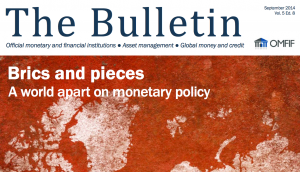OMFIF: US and the IMF move towards acceptance of renminbi in new version of the IMF’s Special Drawing Rights (SDR)
 The London based financial think thank OMFIF carried out an 11-day tour of Asia on 14-25 July encompassing six financial centres. The tour benefited from 48 top-level conversations among them heads of central banks and sovereign funds, other senior government and central bank officials, leading investors, pension funds, economists and academics. OMFIF concludes that the renminbi is part of a multiple reserve currency system already. One Chinese official said that the renminbi could succeed internationally only if it was a ‘quality currency’, which could point towards some form a gold backing in the future . According to OMFIF’s monthly newsletter the number of countries holding renminbi in their official reserves has risen to around 40. And most important from our point of view, the US and the IMF appear to be moving towards acceptance that the renminbi could form part of a ‘redrawn version of the IMF’s Special Drawing Rights‘, which could replace the dollar as the world reserve currency one day.
The London based financial think thank OMFIF carried out an 11-day tour of Asia on 14-25 July encompassing six financial centres. The tour benefited from 48 top-level conversations among them heads of central banks and sovereign funds, other senior government and central bank officials, leading investors, pension funds, economists and academics. OMFIF concludes that the renminbi is part of a multiple reserve currency system already. One Chinese official said that the renminbi could succeed internationally only if it was a ‘quality currency’, which could point towards some form a gold backing in the future . According to OMFIF’s monthly newsletter the number of countries holding renminbi in their official reserves has risen to around 40. And most important from our point of view, the US and the IMF appear to be moving towards acceptance that the renminbi could form part of a ‘redrawn version of the IMF’s Special Drawing Rights‘, which could replace the dollar as the world reserve currency one day.
OMFIF has published ten points on the global economy to sum up the main issues and conclusions discussed during the tour;
1- Policy divisions between western and Asian economies seem to be growing. Increased Asian confidence and resilience are accompanied by belief that the west (and especially Europe) has lost its way. One Asian sovereign fund leader contrasted Asia’s emphasis on long term returns with the short-termism and greed of western investors. ‘The result of the global financial crisis was that the man in the street was devastated while bankers enjoyed their bonuses.’ He highlighted the difference between western rigour on Asia over the 1997-98 financial crisis and European compromises made toward indebted countries in the EMU crisis.
2- The decoupling danger appears most acute for Europe, since the US and Asian economies were seen as more closely aligned. There was talk that the Asian economy, in terms of trade flows, was more integrated than that of the euro area – despite the lack of a common currency. One leading Asian central banker was gloomy about the European outlook, where he said ‘years of restructuring’ were needed, even though economic output (in contrast to Asia and the US) had not yet returned to pre-crisis levels. The most likely scenario for currencies was a firmer tone for US and Asian currencies (with the exception of the yen) and a weaker euro.
3- Belief is growing that prolonged international monetary stimulus seems to be running into diminishing returns and could become self-defeating. There was worry about the long-term impact of very low interest rates on pension funds and insurance companies. Monetary policy could become tighter in Asia to ward off overheating, but countries could not allow exchange rates to take the full strain, so management of capital flows were necessary. Although Asian foreign reserves can be regarded as excessive, this is no longer a major concern for most central banks, which appear wary about losing reserves as a result of foreign exchange or political upsets.
4- The Chinese economy is slowing, but the authorities seem to be in overall macroeconomic control. Growth is likely to be around 7.5% again this year. Main areas of concern are the property market and shadow banking. There were some worries that the authorities are not proceeding fast enough with interest rate liberalisation to accompany capital account liberalisation. The two reforms need to move in tandem so that allowing more capital to leave the country can be accomplished without suffering setbacks. China will be cautious on the latter while refining procedures on the former.
5- Japan seems to have turned a corner with more vigorous implementation of Prime Minister Shinzo Abe’s economic reform measures this summer. Japan seems likely to tolerate a further weakening of the yen as US monetary policy gradually tightens over the next 12 months and the Bank of Japan maintains large-scale purchases of domestic government bonds well into 2015. Although core inflation fell to just 1.3% in June, officials say the rate should be rising towards the 2% target level from the fourth quarter onwards. Officials are relatively confident that Japan is not moving towards permanent current account deficits.
6- There is considerable suspicion about the IMF and an excessively Washington-focused view of 6 the world. Quota reforms and governance changes at Bretton Woods institutions remain stymied by congressional refusal to ratify them. The result is frustration in leading Asian countries and a number of moves – whether through the Chiang Mai reserves-pooling initiative or the latest plan for a Brics bank – for emerging markets to lower their IMF dependence. The result may be deadlock, as the emerging economies themselves lack a consensus to move forward meaningfully on genuine alternative structures.
7- Internationalisation of the renminbi is proceeding on many fronts. The Chinese authorities now accept that the renminbi is, de facto, part of a multiple reserve currency system in which the dollar continues to play the leading role. One Chinese official said that the renminbi could succeed internationally only if it was a ‘quality currency’. The number of countries holding renminbi in their official reserves has risen to around 40. The US and the IMF appear to be moving towards acceptance that the renminbi could form part of a redrawn version of the IMF’s Special Drawing Rights.
8- Internationalisation of the yen seems to be taking on a new form. Tokyo Ministry of Finance 8 officials are stepping up efforts to market Japanese government bonds to central banks and other foreign public sector investors, but purchases of JGBs will take off only after a rise in longer term interest rates from present levels below 1%. A return to more normal JGB interest rates of above 3% – which will prove loss-making for present holders such as the Bank of Japan – is not likely for at least two years. Part of the BoJ/MoF strategy of encouraging Japanese private sector portfolio shifts away from JGBs into equity-type assets is that the BoJ can bear such losses far more easily.
9- Asset managers across the region – both public and private sector – are becoming increasingly internationalised, with some of the older-established funds serving as benchmarks for newer, less mature funds. Large state pension funds in Japan and China are being reformed to bring their asset allocation practices more in line with international standards, with Canadian pension funds – where the proportion of foreign equity ownership is much higher than in Asia – seen as a particular benchmark. Diversification into Asian currencies is an established trend, part of moving away from the dollar as the region’s main transaction currency.
10- Despite general Asian self-confidence, there were warnings that the region could over-stretch itself. Among the challenges are: crossing the threshold to developed country status; improving institutional governance; coping with ageing populations and rising inequality; and promoting financial development. Lack of financial markets may hinder more general economic and trade integration. Cross-border flows were said to be much greater than before the 1997-98 Asia financial crisis – emphasising the need for macroprudential controls now sanctioned by the IMF.


buy viagra
Have you ever considered about including a little bit more than just your articles? I mean, what you say is fundamental and everything. Nevertheless just imagine if you added some great images or video clips to give your posts more, “pop”! Your conte…
This is a great idea, but I only want to use this blog as some extra content which ‘goes with the book’. So i only collect the real Reset high lights for reference